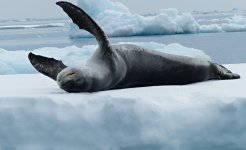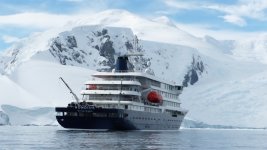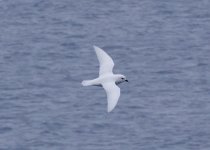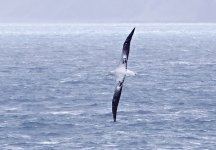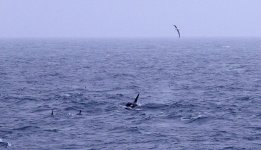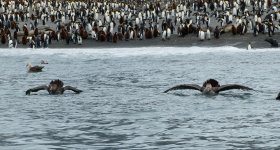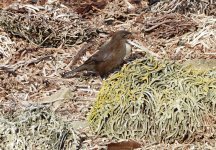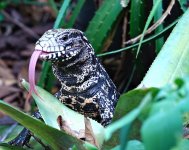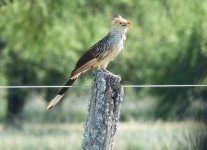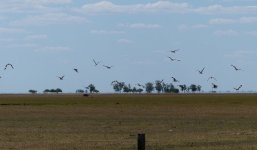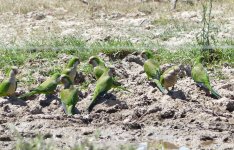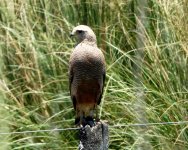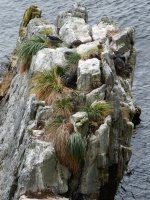
We had originally booked a cruise for 2020, but Corona led to complete cancellations for that period. It was by far not certain that cruises would be possible this time. And it turned out that our company (OCEANWIDE EXPEDITIONS https://www.oceanwide-expeditions.com ) was going to send only two of the four ships they have. There were simply not sufficient bookings in these uncertain times. The ship we were booked on was one of the two that did not go south. So it was by sheer luck (and some insisting) that we were able to get a cabin on one of those that Oceanwide Expeditions did actually send. I had organized and booked all the activities around the 2020 cruise myself, and then had to cancel it all. So this time, with the added uncertainties, I simplified the trip slightly. There was one major advantage coming from the postponement of the planned 2020 trip: by now the long awaited and long overdue Argentina FG had finally come out and I was able to use it for my preparations. J
Our basic itinerary looked like this: Leaving Switzerland on 19 November, arriving in Ushuaia on 21 November, with the ship departing on 26 November. There was a need for some leeway as there were too many uncertainties after Argentina had only reopened its borders again. So we had some days in Ushuaia that we successfully used for birding with a local guide. Esteban Daniels proved to be perfect for us! (Birding Ushuaia). We also benefitted a lot of Esteban’s knowledge of plants and a fine bilingual book he brought along (Flora Patagonia unfortunately out of print). There were two orchids in the NP that only had leaves on our first visit to the Tierra del Fuego NP, but were in almost full bloom on our second visit after the cruise. My personal favorite flower seen on this trip was a Scrophulariacea we encountered in the prairies north of Rio Grande. Its English name of Ladyslipper (Calceolaria uniflora), made me think of an orchid first, but its actual attraction to me was that it reminded me of some comics figures - little men consisting essentially of a wide-open mouth only. All I was missing was that they did not dance. J
The cruise on m/v HONDIUS went counter-clockwise (important, as we later realized) from Ushuaia to the ANTARCTIC PENINSULA, then on to SOUTH GEORGIA with time spent in the zone of totality for the Antarctic Solar Eclipse on the way. Unfortunately, for those who had booked the cruise specifically for that event, there was a thick cloud cover so the only visible event was a short very noticeable darkening. We had about 4 days for South Georgia and then went on to the FALKLAND ISLANDS (Malvinas). Arrival in Ushuaia was on 15 December, where we then had almost two days for birding again. Originally, we would then have made a stop-over in the El Calafate/El Chaltén region. But this time we omitted that part and flew directly to Buenos Aires. From there we made a detour to IGUAZÚ FALLS, then back to Buenos Aires where I was able to squeeze in a full day of birding and a Christmas Day dinner meeting with two of my wife’s cousins before flying back home on 26 December (arriving on the 27th). The only major glitch of the 5½ week trip was a 7 hour delay on the return flight. A multitude of Covid tests had to be passed as well during this tour.
Now for some details:
Ushuaia/Tierra del Fuego:
I had two top priority species for this part, Magellanic Woodpecker and one species of seedsnipe. I did not actually care which one, but I wanted to see at least one member of this intriguing group of shorebirds. In many ways they look like small sandgrouse, and they seem to occupy similar niches in nature. We are approaching the end of our 8th decennium, and I have never been a good uphill walker anyway. So it was great that Esteban proposed going for the Least Seedsnipe instead of the White-bellied Seedsnipe. A fine overnight tour to Rio Grande not only provided great sights of this species. We had not realized that this was going to bring us into fine prairie-type landscapes with quite a few ponds of various sizes. Least Seedsnipes were seen on a few occasions, and unlike the larger White-bellied this smaller species has quite different plumages for males and females. The tour to the Rio Grande area brought some nice mammals as well: Guanacos and South American Grey Fox in particular . And of the bird species among others: Coscoroba Swan, Ashy-headed Goose, Ruddy-headed and Upland Goose, Crested Duck, Yellow-billed Pintail, Speckled Teal, Chiloe Wigeon, Chilean Flamingo, Black-faced Ibis, Andean Condor, Southern Crested Caracara, Magellanic Oystercatcher, Magellanic Plover, Tawny-throated Dotterel, Rufous-chested Dotterel, Two-banded Plover, Hudsonian Godwit, Magellanic Snipe, Short-billed Miner, Common Miner, Buff-winged Cinclodes, Fire-eyed Diucon, Austral Negrito, Correndera Pipit, Patagonian Yellow Finch, Long-tailed Meadowlark.
(part 1 to be continued)
Our basic itinerary looked like this: Leaving Switzerland on 19 November, arriving in Ushuaia on 21 November, with the ship departing on 26 November. There was a need for some leeway as there were too many uncertainties after Argentina had only reopened its borders again. So we had some days in Ushuaia that we successfully used for birding with a local guide. Esteban Daniels proved to be perfect for us! (Birding Ushuaia). We also benefitted a lot of Esteban’s knowledge of plants and a fine bilingual book he brought along (Flora Patagonia unfortunately out of print). There were two orchids in the NP that only had leaves on our first visit to the Tierra del Fuego NP, but were in almost full bloom on our second visit after the cruise. My personal favorite flower seen on this trip was a Scrophulariacea we encountered in the prairies north of Rio Grande. Its English name of Ladyslipper (Calceolaria uniflora), made me think of an orchid first, but its actual attraction to me was that it reminded me of some comics figures - little men consisting essentially of a wide-open mouth only. All I was missing was that they did not dance. J
The cruise on m/v HONDIUS went counter-clockwise (important, as we later realized) from Ushuaia to the ANTARCTIC PENINSULA, then on to SOUTH GEORGIA with time spent in the zone of totality for the Antarctic Solar Eclipse on the way. Unfortunately, for those who had booked the cruise specifically for that event, there was a thick cloud cover so the only visible event was a short very noticeable darkening. We had about 4 days for South Georgia and then went on to the FALKLAND ISLANDS (Malvinas). Arrival in Ushuaia was on 15 December, where we then had almost two days for birding again. Originally, we would then have made a stop-over in the El Calafate/El Chaltén region. But this time we omitted that part and flew directly to Buenos Aires. From there we made a detour to IGUAZÚ FALLS, then back to Buenos Aires where I was able to squeeze in a full day of birding and a Christmas Day dinner meeting with two of my wife’s cousins before flying back home on 26 December (arriving on the 27th). The only major glitch of the 5½ week trip was a 7 hour delay on the return flight. A multitude of Covid tests had to be passed as well during this tour.
Now for some details:
Ushuaia/Tierra del Fuego:
I had two top priority species for this part, Magellanic Woodpecker and one species of seedsnipe. I did not actually care which one, but I wanted to see at least one member of this intriguing group of shorebirds. In many ways they look like small sandgrouse, and they seem to occupy similar niches in nature. We are approaching the end of our 8th decennium, and I have never been a good uphill walker anyway. So it was great that Esteban proposed going for the Least Seedsnipe instead of the White-bellied Seedsnipe. A fine overnight tour to Rio Grande not only provided great sights of this species. We had not realized that this was going to bring us into fine prairie-type landscapes with quite a few ponds of various sizes. Least Seedsnipes were seen on a few occasions, and unlike the larger White-bellied this smaller species has quite different plumages for males and females. The tour to the Rio Grande area brought some nice mammals as well: Guanacos and South American Grey Fox in particular . And of the bird species among others: Coscoroba Swan, Ashy-headed Goose, Ruddy-headed and Upland Goose, Crested Duck, Yellow-billed Pintail, Speckled Teal, Chiloe Wigeon, Chilean Flamingo, Black-faced Ibis, Andean Condor, Southern Crested Caracara, Magellanic Oystercatcher, Magellanic Plover, Tawny-throated Dotterel, Rufous-chested Dotterel, Two-banded Plover, Hudsonian Godwit, Magellanic Snipe, Short-billed Miner, Common Miner, Buff-winged Cinclodes, Fire-eyed Diucon, Austral Negrito, Correndera Pipit, Patagonian Yellow Finch, Long-tailed Meadowlark.
(part 1 to be continued)
Attachments
-
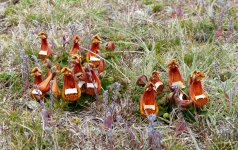 P1040821_Ladyslipper cropret01.jpg1.9 MB · Views: 48
P1040821_Ladyslipper cropret01.jpg1.9 MB · Views: 48 -
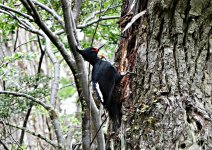 P1040544 Magellanic Woodpecker female.JPG1.3 MB · Views: 53
P1040544 Magellanic Woodpecker female.JPG1.3 MB · Views: 53 -
 P1040866_Least Seedsnipe female .jpg866.7 KB · Views: 48
P1040866_Least Seedsnipe female .jpg866.7 KB · Views: 48 -
 P1040851_Least Seedsnipe from left 2 males -immat & ad- 1 female.jpg1.4 MB · Views: 46
P1040851_Least Seedsnipe from left 2 males -immat & ad- 1 female.jpg1.4 MB · Views: 46 -
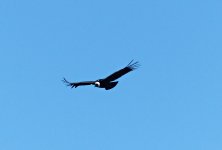 P1040918_Andean Condor.jpg1.4 MB · Views: 42
P1040918_Andean Condor.jpg1.4 MB · Views: 42 -
 P1040687 Long-tailed Meadowlark male.jpg724.5 KB · Views: 48
P1040687 Long-tailed Meadowlark male.jpg724.5 KB · Views: 48
Last edited:




